Table of contents
Are you a fruit lover but already tired of eating the usual bananas, apples, and oranges? Do you want to try something out of the ordinary but still pack the nutritional values you get out of your regular fruit diet? Then, you should visit Costa Rica. This country in Central America has some of the most exotic, bizarre, and rare fruits you could ever find. While the tropical fruits of Costa Rica come in different shapes and sizes, and sometimes may look weird even, one thing is for sure – they will get you hooked the moment you taste them.
Here on this post, we present to you some of the tropical fruits of Costa Rica that are worth a try. Some are big, most are small, others are fragrant while others are not, some are seasonal, but all of them delicious in their own right. Without further ado, here are the Costa Rican fruit gems you must try.
Costa Rica has a lot for you to discover. These healthy, juicy, tropical fruits are a good place to start your tour.
#1
Tropical Fruits Of Costa Rica: Maracuya (Passion Fruit)
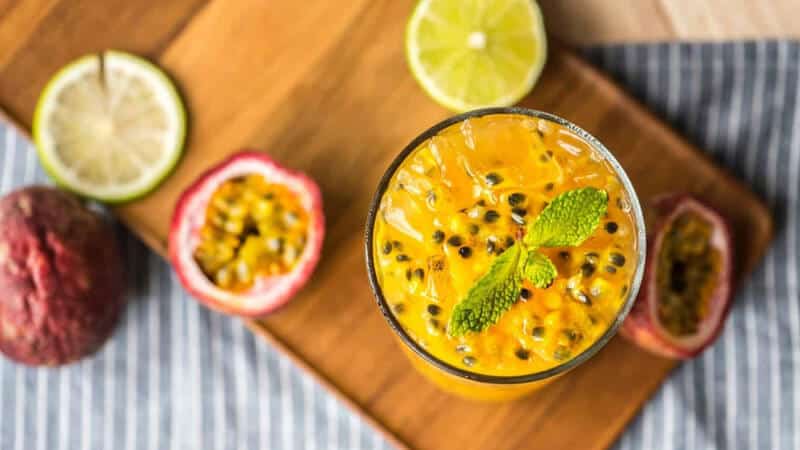
Popularly known as Passion Fruit, maracuya is a tropical fruit shaped like an egg. It has a tough outer rind and juicy, seed-filled center. The fruit is available throughout the year, however, the best time to get maracuya is during the rainy season as they tend to grow more flowers then.
How to Eat Maracuya
While some people enjoy the fruit raw straight out of the rind, many like to use it as ingredient for some dishes. Other ways to enjoy this fruit include:
- Passion fruit juice – by squeezing through a sieve to extract the sweet nectar
- Ingredient for desserts – this fruit is a popular ingredient for cakes as it gives a sweet and unique flavor
- Sweet accent for salads – you can add the fruit to salads to give it a slightly sweet zing
Health Benefits
- Maracuya is a good source of Vitamin A and Vitamin C.
- It’s also a rich source of antioxidants, which helps protect the body from free radicals.
- The fruit contains high amount dietary fiber, which is good for the gut and prevents constipation.
#2
Tropical Fruits Of Costa Rica: Chino Mamon
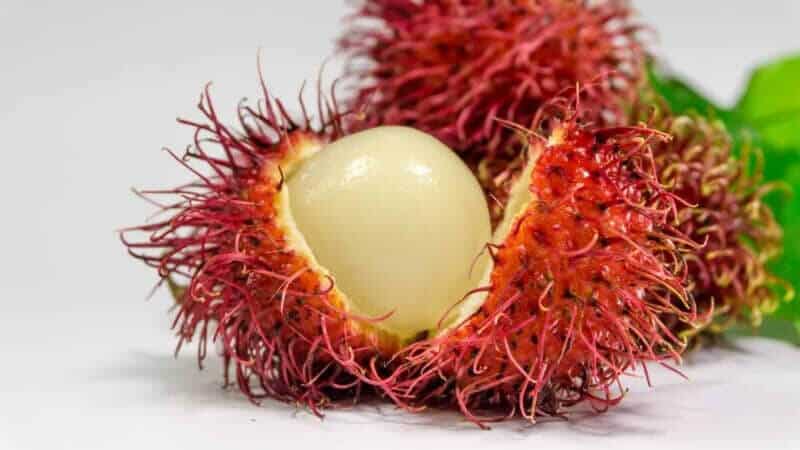
This fruit is originally from Southeast Asia but found its way in the coast of Costa Rica. Also called as “chinese sucker”, the flesh of chino mamon resembles that of a lychee. Chino mamons are distinguished by their red and hairy skin. You can find this little fruit being sold on practically every corner of Costa Rica during the months of July, August, September, and October.
How to Eat Mamon Chinos?
Eating this hairy, funny-looking fruit is quite easy. Just slice it open around the center with a knife or using your fingers and pop off the top. You can also use your teeth to gnaw at it until the fleshy insides are exposed.
Health Benefits
- 100 grams of mamon chino provides approximately 66% of Vitamin C needed by the body daily.
- Mamon chino also contains copper, which plays an important factor for skin, bone health and brain function.
- The fruit has been used as traditional medicine in countries like Indonesia and Malaysia for years to treat conditions such as hypertension and diabetes.
#3
Tropical Fruits Of Costa Rica: Mangoes
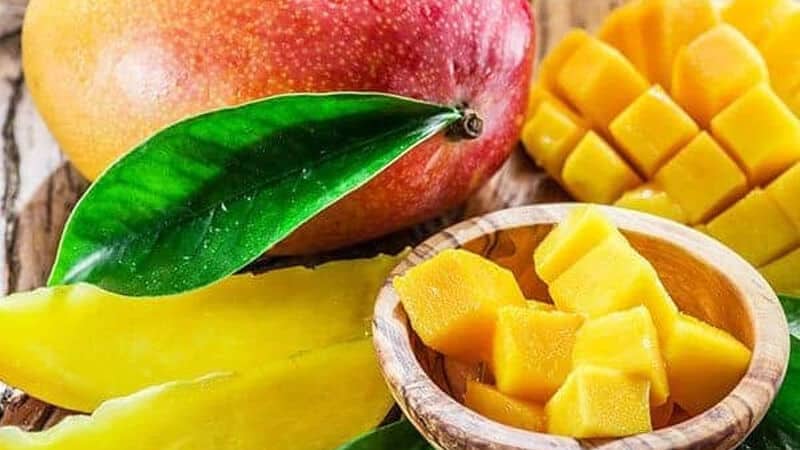
Popularly known as mangas in Costa Rica, mangoes are rich and juicy fruit. Eating it is like biting a velvety fruit covered in honey. Generally, this fruit is tender and succulent, offering a sweet and slightly tangy taste. Mangas or mangoes are available in Costa Rica throughout the year and are sold at 25 cents per pound during high season.
How to Eat Mangoes
A mango is a relatively easy to eat fruit. While there are plenty of ways to eat it, the most popular one is to slice the cheeks lengthwise. This will leave you with three sections – 2 cheeks with pure mango flesh and a center one with the seed part. You can munch on the center one and suck on it remaining flesh just so you will not waste any of it. For the cheeks, you can cut them in a crisscross manner to achieve small cube sized part. Then, turn the skin inside out, and you’ll have perfect mango cubes to savor.
Health Benefits
- Mango is a low-calorie fruit, but is also high in fiber, as well as Vitamin C and A.
- This fruit is an incredible source of antioxidants
- It also contains mangiferin and gallotannin, which help in boosting the immune system
#4
Tropical Fruits Of Costa Rica: Sandia (Watermelon)

Sandia thrives in hot and sunny weathers. That is why Costa Rica is a perfect location to grow them. Also known as watermelon, this fruit has a smooth hard rind with green striped pattern. It has a velvety, juicy, and sweet interior flesh. Sandia is available in Costa Rica all year round, however, prices could slightly go up during off seasons.
How to Eat Sandia
To eat a watermelon you can cut it in wedge shaped slices and bight into it right away. This is the easiest way to enjoy it. If you want to serve it on a plate, you can also try to slice off the rind, leaving you with only the juicy flesh.
Health Benefits
- Watermelons have high (about 92%) water content, which could keep you hydrated especially in Costa Rica’s hot weather.
- Eating it also makes you feel full.
- The fruit is low in calories (about 46 calories per cup), which is a perfect diet alternative if you’re following a strict calorie intake.
- Some of the nutrients found in watermelon are very beneficial, including Vitamin A and C, potassium and magnesium.
- Sandia also contain lycopene, which helps in combating cancer.
#5
Tropical Fruits Of Costa Rica: Jacote
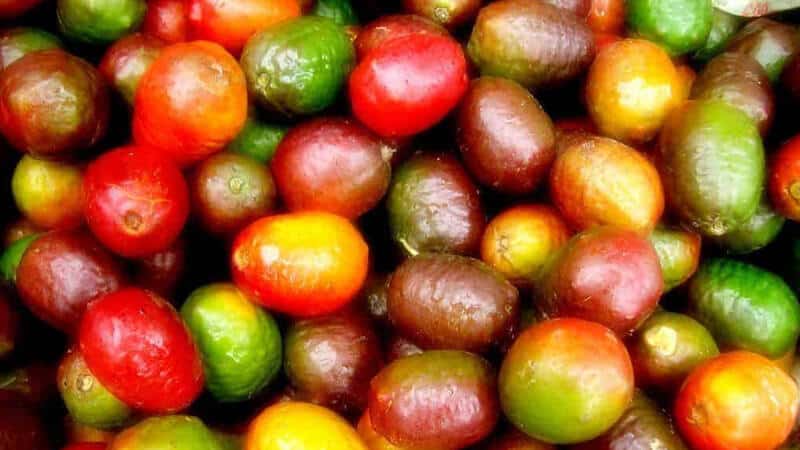
This tiny tropical fruits of Costa Rica is available during the months of August. The color of jacotes varies from dark yellow to green and red. The green jacotes may taste a bit bitter, so it’s best to wait until they’re almost red. One good way to test if jacotes are ready to eat is to slightly squeeze them using your fingers. The softer the feel, the sweeter the fruit.
Subscribe to our newsletter
to stay up to date
How to Eat Jacote
This normal way of eating jacote is to just eat it raw. Munch on it or bite on it until you eat most of the flesh surrounding the tiny seed inside. Aside from eating it raw, many people dry or boil it to use in other dishes.
Health Benefits
- Jacotes are high in antioxidants.
- Also, it promotes healthy digestion.
- The fruit is rich in iron, calcium, phosphorus and nutrients like Vitamin A, B, and C.
- Because of its high nutritional value, the fruit is an excellent way to maintain a strong immune system.
#6
Tropical Fruits Of Costa Rica: Carambola
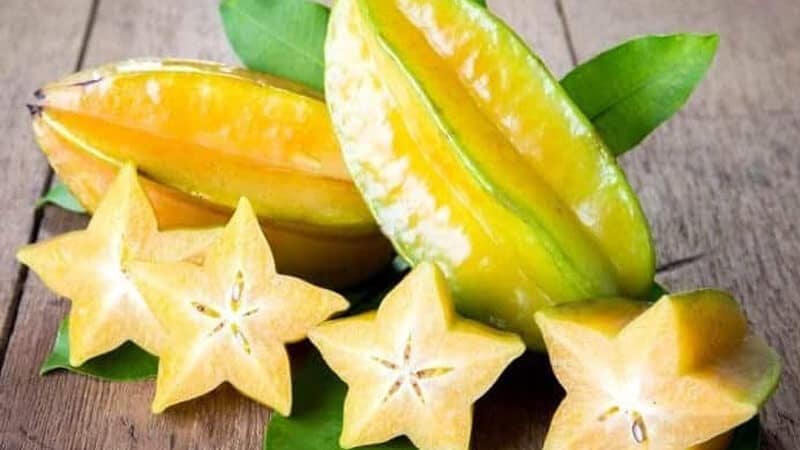
Carambola, also known as star fruit, is a sweet and tangy fruit with a shape of a five-pointed star. This tropical fruit of Costa Rica varies in color – from mild green to yellow. But the Costa Ricans prefer it slightly green as its flesh has a tangy flavor and crunchy texture at that stage. Carambola is available year-round, but are most prevalent from June to October.
How to Eat Carambola
The usual way to eat this fruit is by cutting off the ends, slicing and removing the seeds, and then eating straight away. To make it look appetizing, many prefer to show its unique shape. You can do this by first cutting off both ends, and then cut the fruit crosswise to expose the star-shaped flesh. Because of its unique flavor and appearance, carambola is usually added to salad dishes to make it look more appealing.
Health Benefits
- This fruit is an excellent source of quercetin, gallic acid, and other healthy plant compounds, which prevents the liver from becoming fatty.
- A few studies involving animals show that the fruit also reduces bad cholesterol level and inflammation.
#7
Tropical Fruits Of Costa Rica: Nance
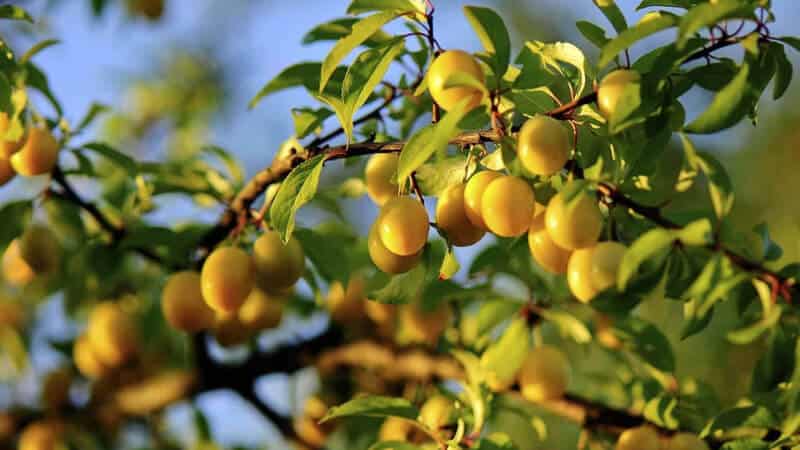
Commonly referred to as Golden Spoon, this Costa Rican tropical fruit is available in the late summer and early fall months. Nance is a small ball-shaped berry with a diamater ranging from only 1 to 2 diameters. This small fruit turns orange or yellow when ripe and their taste (sour or sweet) is completely dependent upon the cultivar.
How to Eat Nance
Nances can be eaten just like cherries – remove the pits and pop it in your mouth. They can also be cooked. Often, this fruit is used to make jams, as well as flavoring for ice creams. In Costa Rica, this fruit is also used to make alcoholic beverages.
Health Benefits of Nance
- Nance is rich in Vitamin C, K, and E
- It also contains thiamine, riboflavin, which helps improve the immune system.
- Besides that, this small fruit contains a significant amount of protein and calcium
#8
Tropical Fruits Of Costa Rica: Pitahaya
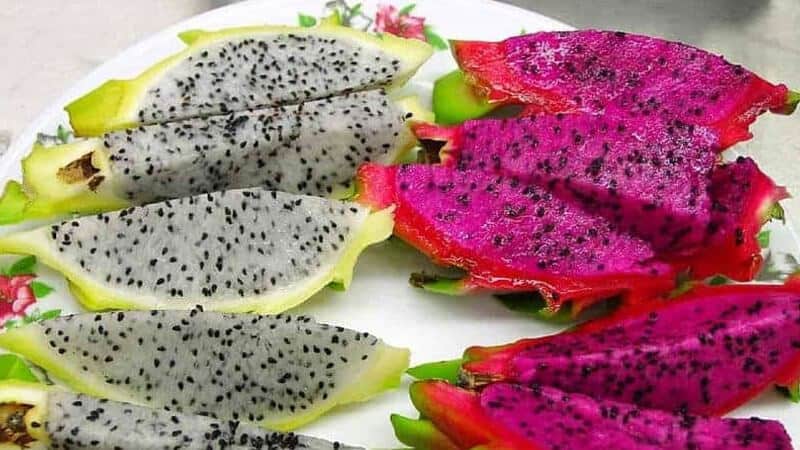
Known in other parts of the world as dragon fruit, pitaya is a weird looking fruit that could have a flesh of either red, white, or yellow in color. Each fruit could weigh as much as 300 grams. What makes this fruit unique is its outer appearance that seems like the scale of some mystic dragon. Pitahayas are known for their mild sweetness, fresh and nutty flavor of their seeds.
How to Eat Pitahaya
Use a sharp knife and cut the fruit in half lengthwise. Then, use a spoon to scoop out the flesh inside. You can also try cutting the fruit wedge style like watermelons so you can eat it straight with the rind. Don’t eat the rind, of course. Other ways of preparing pitahayas include blending the fruit to make a smoothy, adding them to salads, and incorporating them to yoghurt.
Health Benefits
- Pitaya offers about 7 grams of fiber per serving.
- The fruit is also known to promote the growth of good bacteria found in the stomach.
- Finally, the fruit has a high concentration of carotenoids and Vitamin C, which boosts the immune system.
#9
Tropical Fruits Of Costa Rica: Guanabana
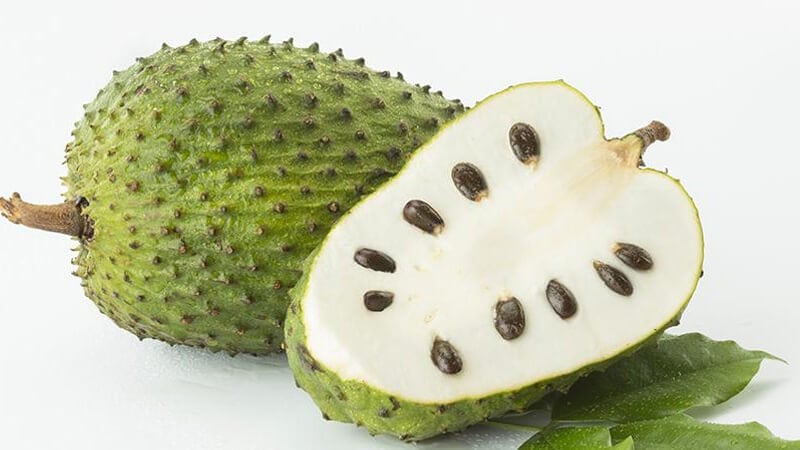
Commonly known as soursop, guanabana is a tropical Costa Rican fruit with green skin and spines. The taste of guanabana is a delicious combination of pineapple and strawberry, with other sweet and citrus notes. This fruit is available from January through June in the local farmer’s market as well as supermarkets in Costa Rica.
How to Eat Guanabana
This fruit can be cracked open. Simply scoop out a section into your mouth, eat the pulp, and spit out the black seeds. The pulp can also be used for desserts, smoothies, beverages, etc.
Health Benefits
- Studies show that guanabana is high in antioxidants, thus helping prevent cell damage in human bodies.
- Guanabana extract can also significantly reduce blood sugar levels.
#10
Tropical Fruits Of Costa Rica: Melon
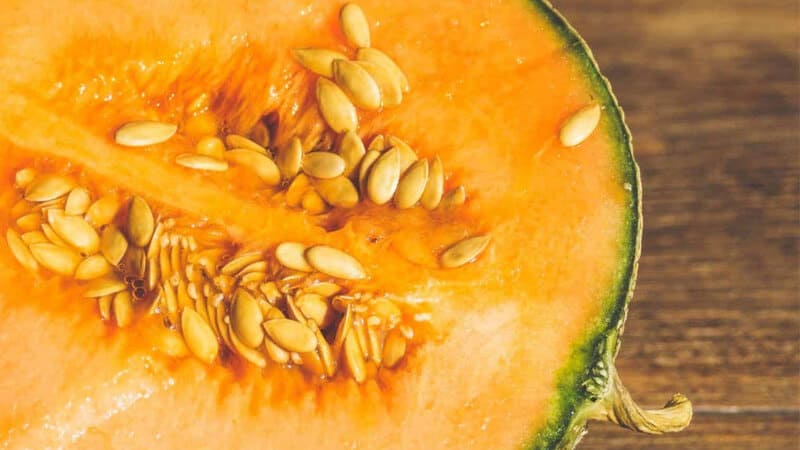
This fruit, also known as cantaloupe or muskmelon, is one of the common tropical fruits of Costa Rica. This fruit is very popular around the world because of its mild, sweet, and juicy taste. Aside from that, it also packs a lot of health benefits. A perfectly ripe melon is juicy, sweet and unctuous. The melon season in Costa Rica runs from January to April.
How to Eat Melon
You can simply cut the melon into half and cut it into wedge slices. Do not forget to scrape out the seeds at the center. Unlike watermelon, melon has no seeds hiding in between the flesh, so you can enjoy it deliciousness without having to spit out the seeds. Other surprising ways to eat them include –
- smoothies
- melon salads, and
- melon sorbets
Health Benefits
- Melons have more beta carotene than oranges and grapefruit. Beta carotene helps fight free radicals that attack healthy cells of the body.
- This fruit also provides 14 percent of potassium DA to help keep the right balance between cells and body fluids.
- Cantaloupes also have a lot of Vitamin C.
There you have it, the unique fruit offerings of Costa Rica that you must try when you next visit this country. If you came here to enjoy the country’s pristine beaches, what’s a better thing to do than order a fresh tropical fruit smoothie while sunbathing, right? Be sure to take note of the in-demand season for seasonal fruits, so won’t be disappointed when you order.
Subscribe to our newsletter
to stay up to date



